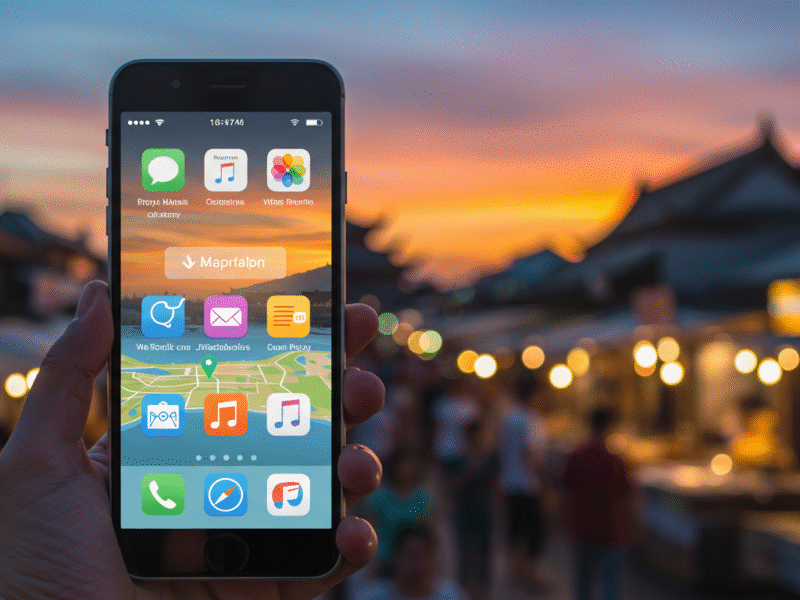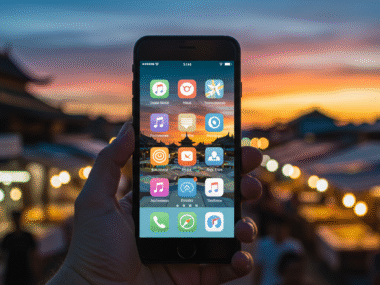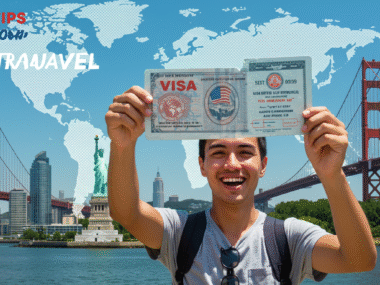Picture this: You’re standing in a bustling foreign market, the sun dipping low, and your phone buzzes with a notification that just saved you from missing your train. That’s the magic of the right travel app—turning potential chaos into seamless adventure. As someone who’s backpacked through Europe on a shoestring and splurged on beach getaways in Southeast Asia, I’ve learned that the best travel apps aren’t just handy; they’re your invisible travel buddy, whispering tips and warnings when you need them most. In this guide, we’ll dive into the must-have travel apps for 2025 that every wanderer, from solo explorers to family road-trippers, should download right now. Whether you’re hunting for budget flights, decoding local menus, or plotting the perfect itinerary, these apps will make your journeys smoother, cheaper, and way more fun. Let’s pack our virtual bags and get started.
Why Travel Apps Are a Game-Changer for Modern Wanderers
Traveling used to mean lugging around dog-eared guidebooks and scribbling notes on napkins. But today? Your smartphone is the ultimate travel toolkit. These apps do more than just point you in the right direction—they help you save money, stay safe, and uncover hidden gems that guidebooks miss. Think about it: With real-time updates on flight delays or crowd levels at popular spots, you avoid the headaches that used to ruin trips.
From my own escapades, I remember getting stranded in a rain-soaked Rome without a map app that worked offline. Lesson learned—apps like these are lifesavers. They’re especially clutch for budget travelers chasing cheap flights or families juggling kid-friendly activities. And the best part? Most are free or low-cost, packing high-value features without the fluff. In a world where travel costs keep climbing, these tools keep your wallet happy and your spirits high. Ready to explore the categories? Let’s break it down.
Read Also:
Navigation and Mapping Apps: Never Get Lost Again
Getting around a new city can feel like solving a puzzle with missing pieces, but the right navigation app turns it into a breeze. These aren’t your grandma’s paper maps; they’re smart, GPS-powered wonders that adapt to traffic, public transit, and even walking routes.
Google Maps: The All-in-One Navigation King
If there’s one app every traveler should use, it’s Google Maps. It’s like having a local friend in your pocket, dishing out directions for driving, walking, biking, or hopping on buses. What sets it apart? Offline maps you can download ahead of time—no Wi-Fi freak-outs in remote spots. Plus, it predicts traffic in real time and even suggests the best time to leave to beat the rush.
I once used it to navigate Tokyo’s maze-like streets during cherry blossom season. Crowds everywhere, but Google Maps routed me through quiet alleys to a perfect picnic spot. Features like Street View let you preview your destination, and the “Explore” tab uncovers nearby eats and sights based on your vibe—vegetarian options or hidden viewpoints. It’s free, works globally, and integrates with rideshares like Uber. Downside? Battery drain on long days, so keep a charger handy. Pro tip: Layer in public transit info for eco-friendly city hopping.
Maps.me: Your Offline Adventure Companion
For off-the-grid explorers, Maps.me is a breath of fresh air. This app shines in areas with spotty signal, like hiking trails in Patagonia or rural drives in New Zealand. Download continent-sized maps once, and you’re set—no data munching.
It’s open-source, meaning it’s community-driven with user-updated trails and POIs (points of interest). I relied on it during a solo trek in Iceland, where cell service vanished for hours. It plotted waterfalls and hot springs with turn-by-turn voice guidance. Voice navigation in multiple languages, bookmarking favorites, and even measuring distances make it a hiker’s dream. Free with optional in-app buys for extras like traffic layers, it’s lightweight and ad-light. The catch? Less polished than Google for urban transit. Ideal for nature lovers dodging roaming fees.
Citymapper: Urban Transit Simplified
Big cities can overwhelm with their subway spaghetti, but Citymapper untangles it all. Focused on metros like New York, London, or Paris, it combines buses, trains, bikes, and even ferries into one seamless plan. Real-time disruptions? It alerts you and reroutes on the fly.
During a hectic weekend in Berlin, Citymapper saved my sanity by factoring in walking times and even calorie burn—handy for guilt-free street food stops. Multi-modal trips, fare calculators, and disruption predictions keep you ahead. It’s free, but premium unlocks offline access. Not as global as others, so pair it with Google Maps for smaller towns. If you’re a city slicker chasing efficient commutes, this is your go-to.
Booking and Planning Apps: Score Deals on Flights, Stays, and More
Nothing kills the travel buzz like overpaying for a hotel or scrambling for last-minute tickets. These apps are deal-hunters, scanning the web for the best prices and building itineraries that flow like a well-oiled machine.
Kayak: The Ultimate Flight and Hotel Hunter
Kayak isn’t just a search engine; it’s a travel hacker’s best friend. Plug in dates, and it scours airlines and hotels for the lowest fares, complete with price forecasts—book now or wait? It tells you. Bundles for flights + cars save big, and the app’s clean interface makes filtering easy (nonstop only, anyone?).
On a whim trip to Bali, Kayak flagged a 30% drop in flight prices overnight. Alerts for price dips meant I snagged business class for economy bucks. Explore tools suggest destinations based on your budget, and Hacker Fares mix carriers for savings. Free with no hidden fees, though it earns from affiliates. Minor con: Occasional glitches in live updates. For budget travel apps, this one’s unbeatable.
Booking.com: Hotels, Homes, and Hidden Stays
Booking.com is the Airbnb alternative for variety—think boutique hotels, apartments, or glamping sites. Genius-level loyalty perks unlock free upgrades, and flexible cancellation eases worries. User reviews with photos give the real scoop.
I booked a cozy cabin in the Scottish Highlands through it, complete with host tips on nearby hikes. The app’s map view pins options by price and rating, and last-minute deals pop up like confetti. Free to use, with secure payments. Drawback: Some listings have extra fees. Perfect for families needing space or couples wanting romance on a dime.
Airbnb: Experiences Beyond the Stay
Airbnb goes deeper than beds—it’s about immersive stays and local tours. Rent a treehouse in Costa Rica or join a cooking class in Marrakech. Superhost filters ensure quality, and the app’s messaging keeps communication smooth.
My unforgettable night in a Moroccan riad came via Airbnb, where the host shared sunset views and tagine recipes. Wishlists save dreams for later, and flexible search by amenities (pool? Pet-friendly?) nails it. Free app, but service fees apply. Con: Vetting for safety takes effort. For unique travel experiences, it’s gold.
Translation and Communication Apps: Bridge the Language Gap
Ever pointed at a menu like a caveman? Translation apps erase that awkwardness, letting you chat, read signs, and haggle like a pro.
Google Translate: Instant Global Chatter
Google Translate is the OG for on-the-go linguistics. Camera translation scans menus or signs in 100+ languages, and conversation mode flips between tongues seamlessly. Offline packs mean no excuses.
In a Vietnamese pho joint, I scanned the board and ordered confidently—spicy beef, hold the mystery herbs. Voice typing and handwriting input handle accents and scripts. Free, with AR for live overlays. Limitation: Nuances can trip it up in slang-heavy spots. Essential for solo travelers abroad.
Duolingo: Learn While You Roam
Not just for classrooms, Duolingo turns downtime into language lessons. Bite-sized sessions on Spanish for Spain or Japanese for Tokyo fit airport waits. Gamified streaks keep you hooked.
I brushed up on Italian before Venice, nailing gelato orders and gondola chit-chat. Travel-specific stories immerse you in scenarios like hotel check-ins. Free with ads, or ad-free for cheap. Pro: Builds confidence over time. Con: Not for deep dives. Pair with Translate for instant wins.
Weather and Packing Apps: Prep for Any Forecast
Mother Nature doesn’t RSVP, so these apps forecast drama and help you pack smart—raincoats or swimsuits?
AccuWeather: Hyper-Local Forecasts
AccuWeather drills down to minute-by-minute rain chances and severe alerts. Global coverage includes air quality and allergy trackers—crucial for asthmatics abroad.
Hiking the Alps, it warned of afternoon storms, letting me summit safely. MinuteCast for hourly precip and connected devices for home checks add smarts. Free, with premium for extras. Downside: Ads in free version. Beats generic apps for precision.
PackPoint: Smart Packing Lists
PackPoint generates custom lists based on destination, weather, and trip type—business or beach? It even reminds for chargers or meds.
For a Thailand monsoon escape, it flagged bug spray and flip-flops. Shareable lists and check-off ease group travel. Free with in-app buys. Con: Generic for ultra-specific needs. Revolutionizes overpacking woes.
Budgeting and Expense Trackers: Keep Your Wallet in Check
Travel eats cash like nobody’s business, but these apps track every latte, turning you into a frugal ninja.
Trail Wallet: Multi-Currency Magic
Trail Wallet logs expenses in any currency, graphing spends by category—food vs. fun. Offline syncing and budget alerts prevent overspends.
Backpacking Australia, it converted AUD on the fly and flagged when souvenirs spiked. Export reports for taxes, too. Free trial, then affordable sub. Minor issue: Learning curve for setups. Top pick for long-haul budget travel apps.
Expensify: Scan and Scan Away
Expensify scans receipts, categorizes, and reimburses—great for work trips. SmartScan reads totals automatically.
Post-conference in Singapore, it tallied meals in seconds. Free for basics, pro for teams. Con: Geared more business. Handy for mixed leisure-work jaunts.
Food and Dining Apps: Eat Like a Local
Hunger strikes anywhere, but these apps find bites that wow without the wallet weep.
TripAdvisor: Reviews and Reservations
TripAdvisor’s massive reviews guide you to authentic eats, with filters for dietary needs. Book tables or tours inside the app.
In Mexico City, it led to a street taco haven off the tourist path. Near Me Now for instant spots, and forums for tips. Free, user-powered. Drawback: Overly negative reviews sometimes. Essential for foodie travelers.
Yelp: Neighborhood Gems
Yelp spotlights local favorites with photos and check-ins. Augmented reality points to nearby haunts.
San Francisco fog lifted my mood with a Yelp-suggested clam chowder spot. Elite badges for trusted reviewers add cred. Free with ads. Con: US-heavy, but globalizing. Perfect for urban munchies.
Transportation Apps: Hail, Train, or Rent with Ease
From taxis to trains, these streamline getting from A to B without the stress.
Uber: Reliable Rides Worldwide
Uber’s on-demand cars, bikes, and even boats (in some spots) track drivers in real-time. Safety features like share-trip shine for solos.
Late-night Lisbon ride? Uber had me home safe. Surge pricing alerts help time it right. Free app, pay per ride. Con: Availability varies. Staple for city hops.
Rome2Rio: Multi-Modal Planner
Rome2Rio maps every transport option—plane, train, bus, ferry—with costs and times. Eco-routes minimize carbon.
Planning a Greece island-hop, it chained ferries and buses perfectly. Free, detailed. Limitation: No bookings inside. Complements others beautifully.
Safety and Emergency Apps: Travel with Peace of Mind
Adventures shouldn’t mean risks—these apps have your back.
TripIt: Itinerary Master
TripIt auto-builds plans from email confirmations, alerting delays or weather issues. Share with family for check-ins.
Euro rail mishap? TripIt rerouted me flawlessly. Free pro version for extras. Con: Email dependency. Organizes chaos into calm.
bSafe: Personal Safety Net
bSafe’s SOS button alerts contacts with location, and fake calls deter creeps. Audio streaming records incidents.
Solo in Bangkok nights, the check-in timer eased worries. Free with premium. Drawback: Battery hog. Vital for women travelers or anyone cautious.
Niche Apps for Special Travelers: Tailored to You
Not one-size-fits-all— these cater to solos, families, or eco-warriors.
For Solo Travelers: Couchsurfing
Connect with locals for free stays and stories. Verified hosts and events build community.
My Couchsurfing night in Barcelona sparked lifelong friendships. Free, community-moderated. Con: Safety first—meet public. Fosters authentic bonds.
For Families: Peanut
Not just moms—Peanut links parents for playdates abroad. Forums share kid tips.
Paris with tots? Found a park meetup via Peanut. Free app. Limitation: Niche focus. Eases family jet lag.
For Eco-Travelers: Good On You
Rates brands’ sustainability for ethical shopping on the road. Scans for green hotels too.
Eco-safari in Kenya, it vetted outfits. Free, research-backed. Con: Fashion-heavy. Aligns trips with values.
Tips to Maximize Your Travel App Arsenal
Don’t just download—use them smart. Start with a folder on your home screen for quick access. Enable notifications sparingly to avoid buzz overload. Backup data to the cloud, and test offline modes pre-trip. Mix and match: Google Maps for nav, Kayak for deals, TripIt for plans. For battery life, dim screens and close background apps. And remember, apps enhance, not replace, the joy of getting lost sometimes—that’s where the best stories hide.
Security-wise, use VPNs on public Wi-Fi and two-factor auth. Update regularly for bug fixes. For kids, parental controls on apps like YouTube keep screens safe. Budget travelers, set alerts across apps for flash sales. Families, share locations via Find My for reunions. The key? Curate your five favorites to avoid app fatigue.
Emerging Travel Apps to Watch in 2025
The app world evolves fast. Keep eyes on AI-powered ones like TripActions for corporate perks or Wanderlog for collaborative planning. VR previews via apps like YouVisit let you “tour” before booking. Voice-activated like Alexa Skills for travel queries are rising too. Stay tuned—your next must-have could drop tomorrow.
Wrapping Up: Your App-Enabled Adventures Await
There you have it—the best travel apps every traveler should use, from mapping marvels to safety shields. I’ve shared these because they’ve transformed my trips from stressful scrambles to soul-filling stories. Whether you’re a newbie nomad or seasoned globetrotter, downloading a few will up your game instantly. So, charge that phone, pick your poison, and hit the road. Safe travels, and may your paths be ever winding toward wonder.
For deeper dives into solo travel hacks, check out this ultimate solo travel guide . And if you’re plotting your next escape, grab inspiration from these budget backpacking itineraries.











